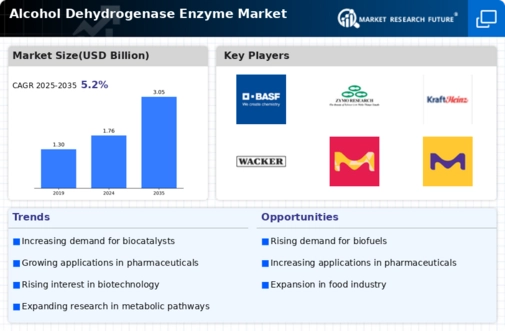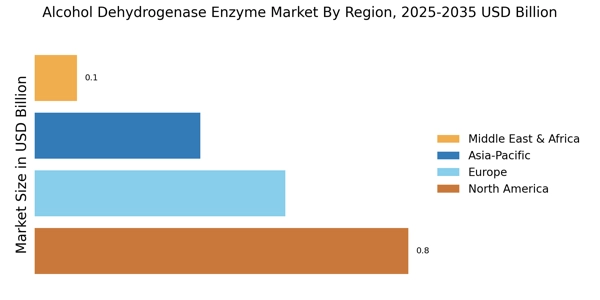Advancements in Biotechnology
The Alcohol Dehydrogenase Enzyme Market is significantly influenced by advancements in biotechnology. Innovations in enzyme engineering and production techniques have led to the development of more efficient and cost-effective alcohol dehydrogenase enzymes. These advancements not only improve the yield of alcohol production but also enhance the overall quality of the final product. For instance, the introduction of recombinant DNA technology has enabled the production of enzymes with superior properties, which are increasingly being adopted by manufacturers. As a result, the market for alcohol dehydrogenase enzymes is projected to grow at a compound annual growth rate (CAGR) of around 7% over the next five years, reflecting the positive impact of biotechnological innovations on the industry.
Rising Interest in Craft Beverages
The Alcohol Dehydrogenase Enzyme Market is witnessing a rise in interest in craft beverages, which is reshaping the landscape of alcohol production. Consumers are increasingly seeking unique and artisanal products, leading to a proliferation of small-scale breweries and distilleries. This trend is particularly evident in regions where local ingredients and traditional methods are emphasized. As craft producers strive to differentiate their offerings, the demand for specialized alcohol dehydrogenase enzymes that enhance flavor profiles and fermentation efficiency is likely to increase. Market analysts suggest that the craft beverage segment could account for a substantial share of the overall alcoholic beverage market, further driving the need for innovative enzyme solutions.
Growing Awareness of Enzyme Applications
The Alcohol Dehydrogenase Enzyme Market is benefiting from a growing awareness of the diverse applications of enzymes in various sectors. Beyond traditional alcohol production, there is an increasing recognition of the role of alcohol dehydrogenase enzymes in pharmaceuticals, food processing, and biofuels. This expanded understanding is prompting manufacturers to explore new applications for these enzymes, thereby broadening the market scope. The potential for alcohol dehydrogenase enzymes to be utilized in developing sustainable biofuels is particularly noteworthy, as the global shift towards renewable energy sources continues. As industries seek to adopt greener practices, the demand for enzymes that facilitate efficient alcohol conversion processes is expected to rise, contributing to the overall growth of the market.
Regulatory Support for Alcohol Production
The Alcohol Dehydrogenase Enzyme Market benefits from favorable regulatory frameworks that support alcohol production. Governments in various regions are implementing policies that promote the growth of the alcoholic beverage sector, recognizing its economic significance. For example, tax incentives and subsidies for distilleries and breweries are becoming more common, encouraging investment in alcohol production facilities. This regulatory support is likely to drive the demand for alcohol dehydrogenase enzymes, as producers seek to optimize their fermentation processes to comply with quality standards and enhance production efficiency. The increasing number of licensed producers is expected to further stimulate the market, as they require reliable enzyme solutions to meet consumer demands.
Increasing Demand for Alcohol-Based Products
The Alcohol Dehydrogenase Enzyme Market is experiencing a notable surge in demand for alcohol-based products, particularly in the beverage sector. This trend is driven by a growing consumer preference for alcoholic beverages, including craft beers and premium spirits. According to recent data, The Alcohol Dehydrogenase Enzyme Market is projected to reach approximately 1.5 trillion USD by 2026, indicating a robust growth trajectory. This increase in consumption directly correlates with the need for efficient alcohol production processes, thereby enhancing the demand for alcohol dehydrogenase enzymes. These enzymes play a crucial role in the fermentation process, facilitating the conversion of sugars into alcohol, which is essential for meeting the rising consumer expectations for quality and flavor in alcoholic beverages.


















Leave a Comment